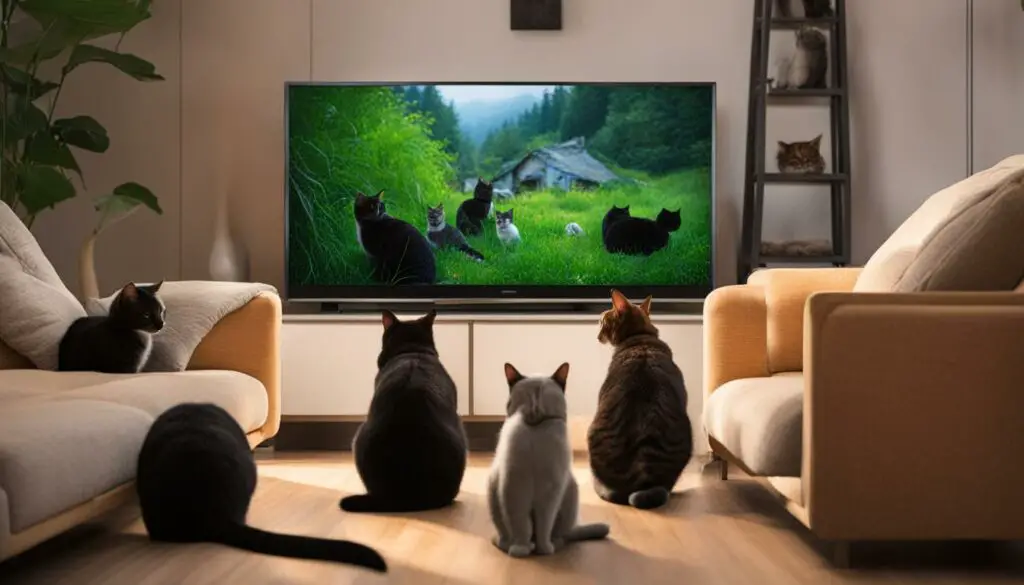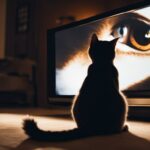Cats are known for their curiosity and interest in the world around them. One interesting behavior that has caught the attention of cat owners and researchers alike is their apparent fascination with watching TV. Many cat owners have noticed that their furry friends show a keen interest in the screen, often captivated by moving images and sounds. But do cats actually enjoy watching TV, or is it just a coincidence? Let’s explore this curious feline behavior.
Key Takeaways:
- Cats are curious creatures who often show a keen interest in watching TV.
- The visual and auditory stimuli of TV content can captivate cats and trigger their natural instincts.
- YouTube videos tailored to feline interests, such as those featuring small animals, are particularly popular among cats.
- Virtual entertainment specifically designed for cats, incorporating elements of virtual reality, can provide an immersive and engaging experience.
- TV watching can be beneficial for cats, providing relaxation, mental stimulation, and enrichment in their daily lives.
Cats and the World of YouTube Videos
YouTube has become a feline haven, offering a plethora of videos that cater to our furry friends‘ unique interests. Channels like Little Kitty & Family, Handsome Nature, and Videos for Your Cat have gained popularity by providing captivating footage of small animals, enticing cats to indulge in their natural stalking, chasing, and hunting instincts. These videos have become a hit among cats, with some channels amassing millions of views. Additionally, animated videos formatted like games, such as Cat Games, have also proven to be engaging for cats, providing both mental and physical stimulation.
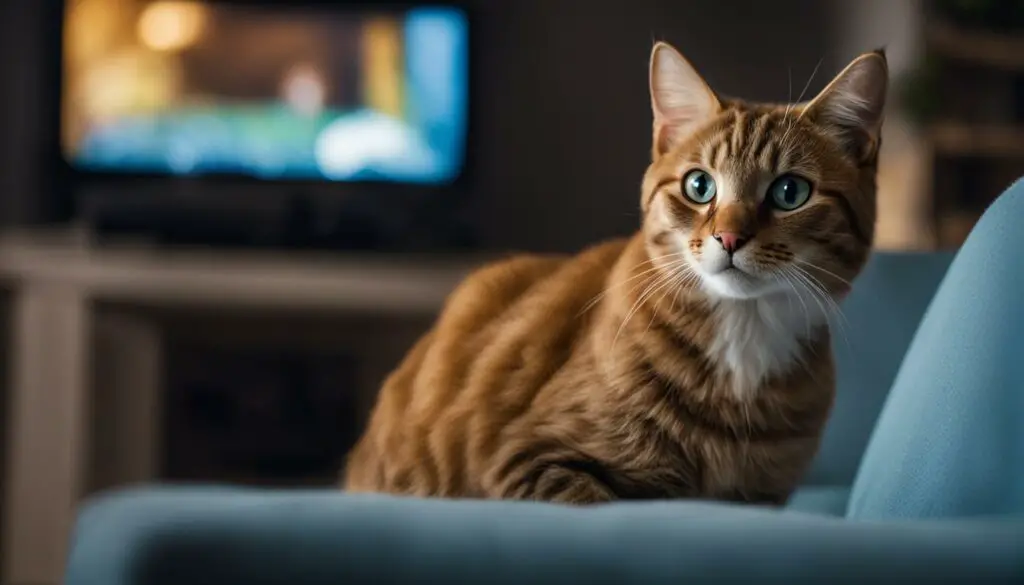
Cats have found a new form of entertainment on YouTube, where they can vicariously experience the thrill of hunting without leaving the comfort of their homes,” says cat behaviorist Dr. Emily Anderson. “These videos tap into their natural instincts and provide a source of enrichment and amusement for them.”
As cats tune into YouTube, they are exposed to a variety of content that piques their curiosity. Nature shows featuring wildlife are particularly popular among feline viewers, as they showcase prey-like movements and trigger cats’ hunting instincts. Cats are also drawn to videos featuring birds, fish, or mice, as the sight of these creatures on the screen ignites their innate desire to pounce and capture. Nature sounds and movement further enhance a cat’s engagement, making YouTube a captivating source of entertainment for our feline companions.
Popular YouTube Channels for Cats
| Channel | Content | Subscriber Count |
|---|---|---|
| Little Kitty & Family | Footage of small animals, nature scenes | 3.5 million |
| Handsome Nature | Wildlife documentaries, bird videos | 2.8 million |
| Videos for Your Cat | Interactive games, animated videos | 4.2 million |
The Appeal of Virtual Entertainment for Cats
As technology continues to advance, virtual entertainment for cats has become increasingly popular. Virtual reality and interactive videos designed specifically for feline viewers offer a unique and engaging experience. These interactive videos simulate prey-like movements and sounds, tapping into cats’ natural instincts and triggering their visual and auditory response. The use of technology in these videos creates a more immersive and interactive experience for cats, enhancing their engagement and enjoyment.
Virtual entertainment for cats provides a form of mental stimulation and enrichment, helping to alleviate boredom and keep cats mentally and physically active. The interactive nature of these videos encourages cats to interact with the screen, pawing at moving objects and attempting to catch virtual prey. This engagement provides both mental and physical exercise, contributing to a cat’s overall well-being.
Additionally, virtual entertainment offers a safe and controlled environment for cats to explore their hunting instincts. Cats can experience the thrill of the hunt without causing harm to themselves or other animals. This type of stimulation can be particularly beneficial for indoor cats who may not have access to outdoor hunting opportunities. Virtual entertainment provides a way for cats to satisfy their natural instincts and engage in a rewarding and enriching activity.
Overall, the appeal of virtual entertainment for cats lies in its ability to provide interactive, engaging, and stimulating experiences. The use of technology and virtual reality creates a unique and immersive environment that captures cats’ attention and triggers their natural responses. As technology continues to evolve, it’s likely that virtual entertainment for cats will become even more advanced, offering even more interactive and engaging experiences for our feline companions.
| Advantages of Virtual Entertainment for Cats | Benefits for Cats |
|---|---|
| 1. Simulates prey-like movements and sounds | 1. Provides mental stimulation and enrichment |
| 2. Interactive nature encourages engagement | 2. Alleviates boredom and keeps cats active |
| 3. Safe and controlled hunting experience | 3. Satisfies natural instincts for indoor cats |
| 4. Captures attention and triggers natural responses | 4. Enhances overall well-being |
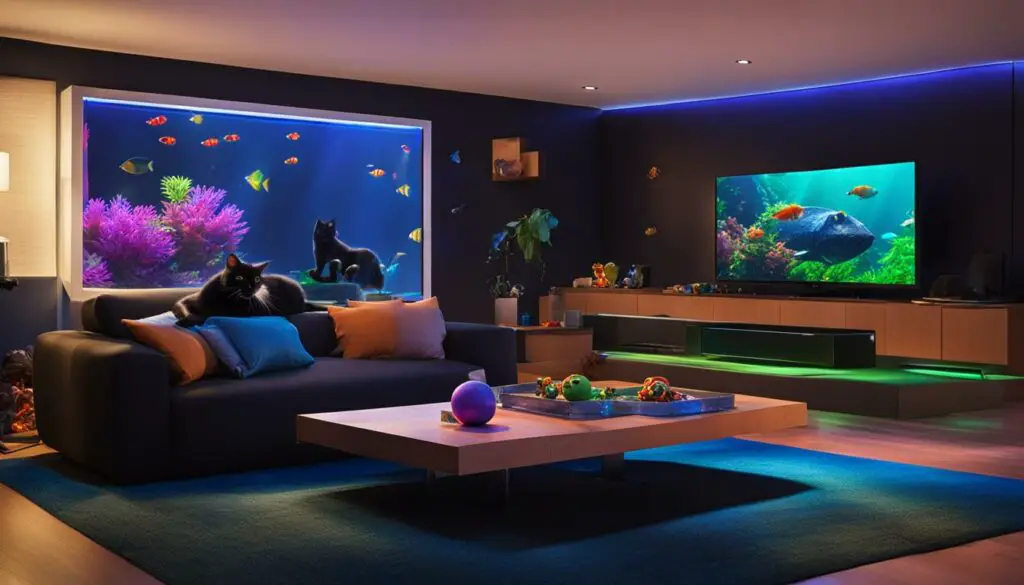
The Benefits of TV Watching for Cats
Watching TV can provide various benefits for cats. Just like humans, cats need relaxation and amusement in their lives. TV watching can serve as a form of enrichment, providing mental stimulation and engagement. It can also be a source of entertainment and enjoyment for cats, helping to alleviate boredom and keep them mentally and physically active. Many cat professionals and organizations recommend TV watching as a way to enhance a cat’s environmental enrichment and overall well-being.
The Benefits of TV Watching for Cats
Relaxation: Cats often find watching TV to be a relaxing activity. The gentle movements on the screen and soothing sounds can create a calming effect, helping cats to unwind and destress.
Amusement: TV content can be highly amusing for cats, especially if it consists of playful and engaging visuals. The sight of birds fluttering or fish swimming on the screen can captivate a cat’s attention and provide hours of entertainment.
Enrichment: TV watching can provide mental stimulation for cats. The changing scenes, movement, and sounds can engage their senses and trigger their natural curiosity. This helps to keep their minds active and prevents boredom.
Engagement: Cats often interact with the TV by pawing at the screen or trying to catch the moving images. This physical engagement can provide exercise and keep cats mentally and physically stimulated.
Enjoyment: Many cats genuinely enjoy watching TV. Their curiosity and interest in the screen indicate that they find the content engaging and enjoyable.
| Benefits | Explanation |
|---|---|
| Relaxation | Cats find watching TV relaxing and soothing. |
| Amusement | TV content can be highly amusing for cats, providing entertainment and captivation. |
| Enrichment | TV watching provides mental stimulation and prevents boredom. |
| Engagement | Cats interact with the TV, providing physical exercise and mental stimulation. |
| Enjoyment | Many cats genuinely enjoy watching TV and find it engaging. |

Cats’ Response to TV Content
When it comes to TV content, cats have their individual preferences. Some felines are captivated by nature shows that feature wildlife, while others may be more interested in animated movies or documentaries. The programming that sparks a cat’s interest often includes visuals of birds, fish, or mice, as these trigger their natural hunting instincts. Additionally, nature sounds and movement play a role in attracting a cat’s attention.
Cats’ response to TV content can vary greatly from one individual to another. Just like humans, cats have unique personalities and preferences. Some may prefer action-packed shows with fast-paced movement, while others may prefer documentaries that showcase serene natural landscapes. It’s important for cat owners to observe their cat’s reactions and adjust the TV-watching experience accordingly.
While researchers are still exploring the specifics of why cats respond to certain TV content, it’s clear that visual and auditory stimuli play a significant role. The programming that appeals to cats often taps into their natural instincts, providing a source of entertainment and engagement. By catering to a cat’s preferences, owners can create a more enjoyable TV-watching experience for their furry companions.
| Favorite TV Genres for Cats | Examples |
|---|---|
| Nature shows | Planet Earth, The Blue Planet |
| Animated movies | The Lion King, Finding Nemo |
| Documentaries | March of the Penguins, The Secret Life of Cats |
| Wildlife footage | Birds in flight, Fish swimming |
Expert Insight:
“Cats are naturally curious creatures, and their response to TV content is a fascinating behavior to observe. The programs that captivate them often tap into their hunting instincts and provide enrichment. By understanding a cat’s individual preferences, owners can tailor the TV-watching experience, providing mental stimulation and entertainment for their feline friends.” – Dr. Sarah Johnson, Feline Behaviorist
A Cat’s Perspective: The Joy of TV Watching
As a cat, I can confidently say that I thoroughly enjoy watching TV. It’s a source of relaxation, engagement, and amusement for me. When I see those moving images on the screen, I can’t help but be fascinated. Whether it’s birds flying, fish swimming, or mice scurrying, I find myself captivated by the sights and sounds.
TV watching provides me with a sense of relaxation. It’s a moment where I can sit back, unwind, and enjoy some quality entertainment. The movements on the screen are visually stimulating, and I often find myself getting lost in the storyline or the beauty of nature portrayed.
Not only is TV relaxing, but it also engages my curiosity. I love seeing animals in action, and watching them on TV provides a unique form of entertainment. It triggers my hunting instincts, and sometimes I can’t help but let out a little paw swipe as if I’m trying to catch that elusive prey. It’s a playful experience that keeps me mentally and physically active.
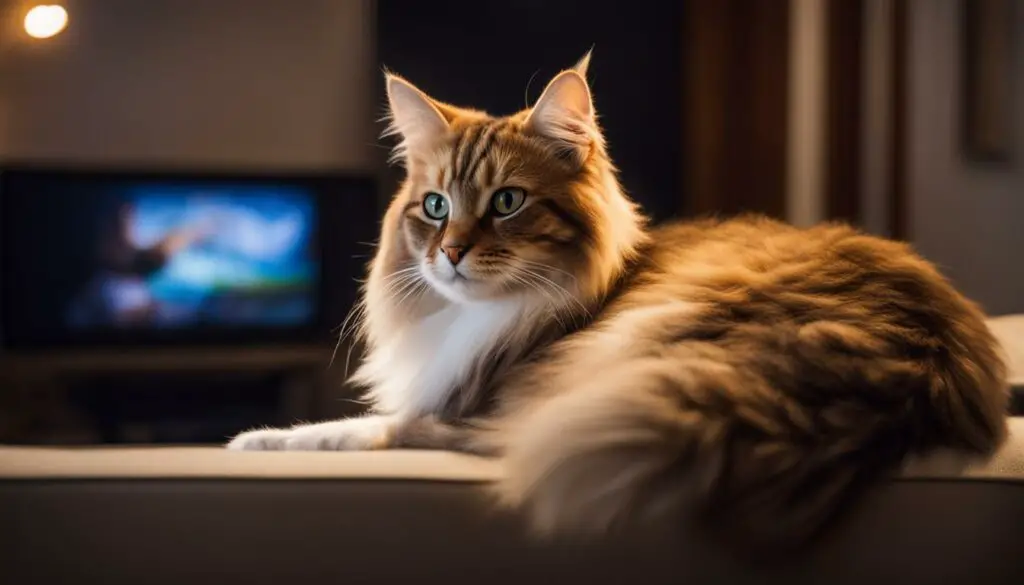
In conclusion, as a cat, TV watching brings me joy and enrichment. It’s a fascinating experience that allows me to relax, engage, and be amused. So the next time you see your feline friend glued to the TV screen, know that we are most likely experiencing the same enjoyment and wonder that you do. Now, if you’ll excuse me, it’s time for my favorite show to start!
Research and Expert Insights
While the phenomenon of cats watching TV is still relatively new and not extensively studied, there are some insights from experts in the field of feline behavior. According to cat behaviorists, TV watching can have potential enrichment benefits for cats, providing mental stimulation and engagement. They suggest that the visual and auditory stimuli presented in TV content tap into cats’ natural instincts and can be a source of enjoyment for them.
“TV watching can be a form of environmental enrichment for indoor cats,” says Dr. Emily Wilson, a renowned cat behaviorist. “Cats are natural predators, and TV content that depicts prey-like movements and sounds can engage their hunting instincts and provide mental stimulation.”
Veterinary professionals also recognize the benefits of TV watching for cats. They recommend videos as a tool to enhance a cat’s environment and improve their mental well-being. Dr. Sarah Thompson, a veterinarian specializing in feline behavior, suggests incorporating TV watching into a cat’s daily routine as a way to provide enrichment and prevent boredom.
Although more research is needed to fully understand the impact of TV watching on cats, the insights from experts highlight the potential benefits and enrichment that this activity can provide. By incorporating appropriate TV content into their cats’ lives, owners can help promote their mental health and overall well-being.
| Expert Insights | Enrichment Potential | Mental Health | Veterinary Recommendations |
|---|---|---|---|
| Dr. Emily Wilson (Cat Behaviorist) | TV watching can be a form of environmental enrichment for indoor cats. | Cats’ natural instincts are engaged, providing mental stimulation. | – |
| Dr. Sarah Thompson (Veterinarian) | – | – | Cats can benefit from incorporating TV watching into their daily routine for enrichment and preventing boredom. |
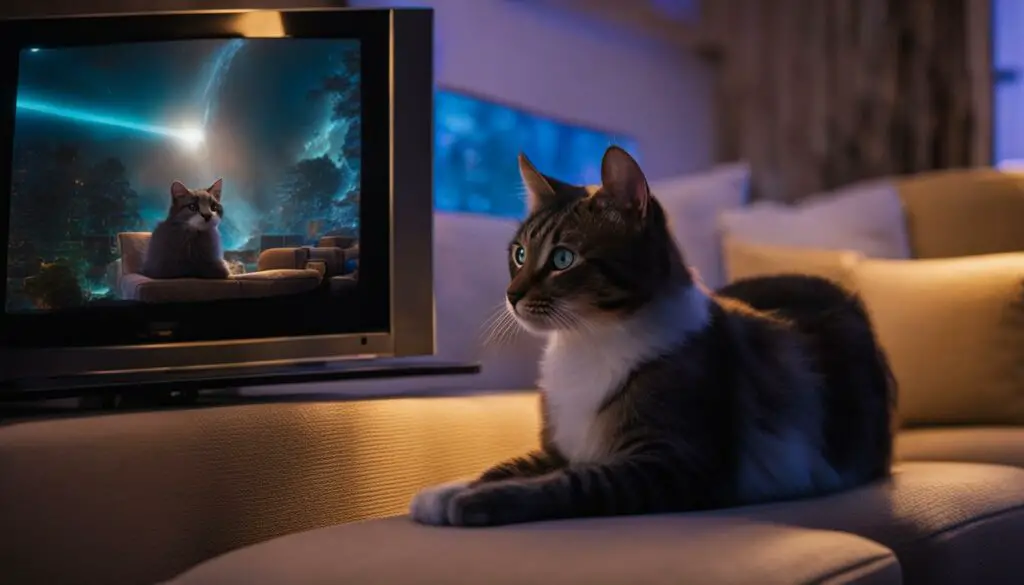
These expert insights offer valuable perspectives on the potential benefits of TV watching for cats. While further research is needed to fully understand the effects, cat owners can consider incorporating this activity into their cats’ lives as a way to provide mental stimulation, enrichment, and enjoyment.
The Impact of TV Watching on Cats’ Mental Health
TV watching can have a positive impact on cats’ mental health. It provides an outlet for mental stimulation, which can help reduce stress and anxiety in cats. The visual and auditory stimuli provided by TV content can create a more enriching environment for cats, alleviating boredom and providing them with opportunities for entertainment and engagement. Ultimately, by providing a source of mental stimulation and relaxation, TV watching can contribute to a cat’s overall psychological well-being.
Stress reduction is a significant benefit of TV watching for cats. Just like humans, cats can experience stress and anxiety, which can have negative effects on their well-being. The visual and auditory stimuli provided by TV content can help distract cats from their worries and provide a form of relaxation. This can be especially beneficial for cats in stressful situations, such as those living in multi-cat households or those recovering from illness or trauma.
Furthermore, TV watching can provide mental stimulation for cats. Cats are intelligent and curious creatures, and they need mental exercise to prevent boredom and keep their minds sharp. Watching TV can stimulate their senses, challenge their cognitive abilities, and provide a form of mental enrichment. Whether it’s watching nature documentaries that showcase their hunting instincts or engaging with interactive videos that simulate prey-like movements, TV watching can keep cats mentally stimulated and engaged.
Overall, TV watching can play a significant role in promoting cats’ psychological well-being. By reducing stress, providing mental stimulation, and offering a source of relaxation and entertainment, TV watching can contribute to a cat’s overall happiness and quality of life. As responsible cat owners, it’s important to provide cats with a healthy balance of TV watching, ensuring moderation, appropriate content, and a safe viewing environment to ensure their mental health is prioritized.
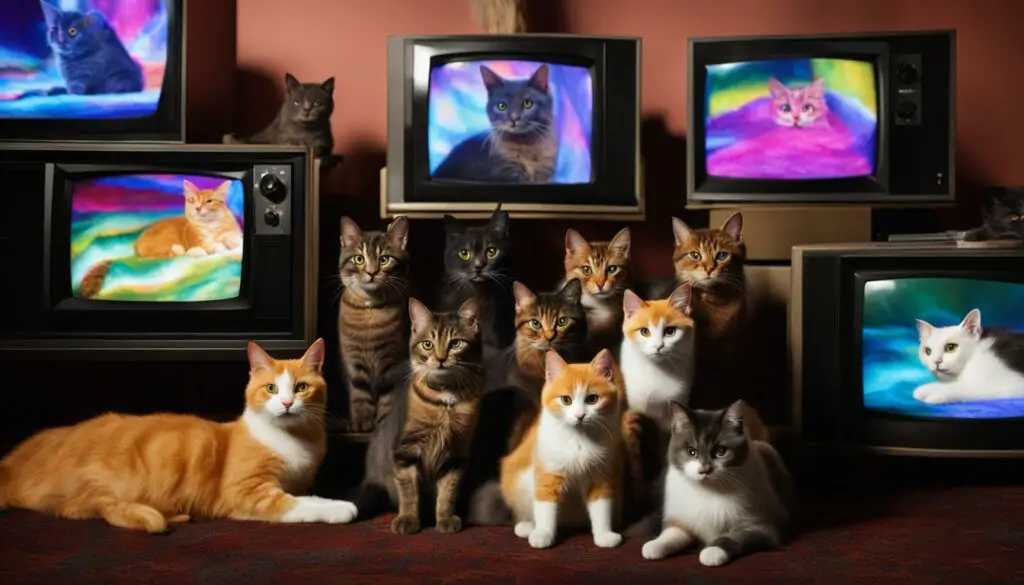
The Benefits of TV Watching for Cats
| Benefits | Description |
|---|---|
| Stress Reduction | TV watching can help distract cats from their worries and provide a form of relaxation, reducing stress and anxiety. |
| Mental Stimulation | TV content can stimulate cats’ senses and provide mental exercise, keeping their minds sharp and preventing boredom. |
| Enrichment | TV watching can provide a source of entertainment and engagement, keeping cats mentally and physically active. |
Considerations for Responsible TV Watching
When it comes to letting our cats watch TV, it’s important to approach this activity responsibly. While TV watching can provide mental stimulation and entertainment for our feline friends, there are a few key considerations to keep in mind.
Ey
e Protection:
It’s essential to protect our cats’ eyes when they are watching TV. Make sure the screen is at a safe distance from their eyes and adjust the brightness levels to prevent any discomfort or damage. Remember that cats have sensitive eyes, so it’s crucial to take precautions to ensure their well-being.
Moderation:
Just like with any form of entertainment, moderation is key. Cats should not spend excessive amounts of time watching TV, as it can lead to overstimulation or addiction-like behavior. Set specific time limits for TV watching and provide other forms of stimulation, such as interactive toys, to maintain a healthy balance.
Appropriate Content:
Choosing the right content is essential to ensure a positive TV-watching experience for our cats. Opt for videos that align with their interests and trigger their natural instincts, such as videos featuring birds or fish. Avoid content that may cause distress or fear, as this can have a negative impact on their well-being.
| Considerations for Responsible TV Watching |
|---|
| Eye Protection |
| Ensure the screen is at a safe distance and adjust brightness levels. |
| Moderation |
| Set time limits and provide other forms of stimulation. |
| Appropriate Content |
| Choose videos that align with their interests and trigger their natural instincts. |
By following these considerations for responsible TV watching, we can ensure that our cats have a safe and enjoyable experience. Remember to prioritize their well-being and provide a balanced and enriching environment for their overall health and happiness.
Individual Variations in TV Preferences
Just like humans, cats have their individual preferences when it comes to TV watching. While some may be captivated by nature shows featuring wildlife, others may prefer animated videos or cartoons. Cats are often particularly interested in videos that depict birds, fish, or mice, as these trigger their hunting instincts. The specific content that appeals to cats may vary, including favorite channels or shows that capture their attention.
Observing your cat’s reactions can provide valuable insights into their preferences. Some cats may exhibit signs of relaxation, engagement, and even attempt to interact with the images by pawing at the screen. By paying attention to these cues, you can tailor the TV-watching experience to suit your cat’s individual interests and provide a more enjoyable and engaging experience for them.
Preferred TV Content for Cats
| Favorite Channels | Specific Content |
|---|---|
| Nature shows | Videos depicting birds, fish, mice |
| Animated videos | Videos formatted like games |
| Cat-targeted footage of small animals | Videos that simulate prey-like movements and sounds |
Remember that each cat is unique, and their preferences may change over time. It’s important to regularly assess what content captures your cat’s attention and adjust their TV-watching experience accordingly. By providing a variety of engaging content that aligns with your cat’s interests, you can ensure they have a rewarding and enjoyable time in front of the screen.
Quotes:
“My cat, Fluffy, absolutely loves watching nature shows. She gets so excited whenever there’s a scene with birds or fish. It’s entertaining to see her reactions and it’s become our bonding time!” – Cat owner
“I’ve noticed that my cat, Whiskers, prefers animated videos and anything that involves interactive gameplay. He loves pawing at the screen and it keeps him mentally stimulated.” – Cat owner
The Evolution of Cat Entertainment
The digital age has brought about significant advancements in modern technology, and cats have not been left behind in the world of entertainment. With interactive experiences becoming more accessible, cats now have a wide range of options to keep them mentally and physically stimulated. From traditional TV watching to interactive games and virtual reality, the evolution of cat entertainment in the digital age has opened up new possibilities for feline enrichment.
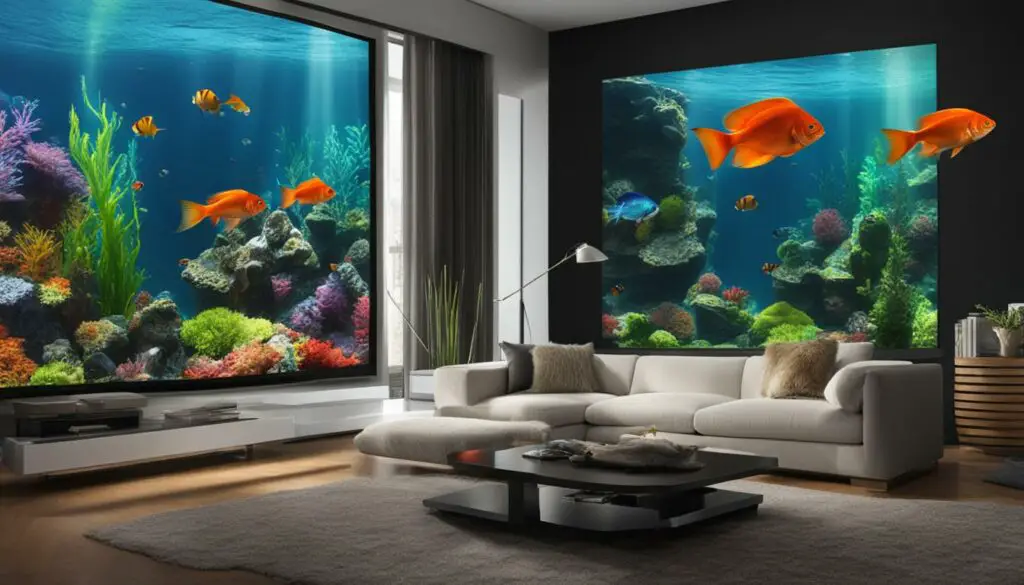
Interactive experiences such as interactive cat toys and apps provide cats with engaging and interactive content. These experiences often mimic real-life hunting and play behavior, allowing cats to engage their natural instincts in a safe and controlled environment. Cats can now enjoy interactive games that require them to chase virtual prey or solve puzzles, providing mental and physical stimulation.
In addition to interactive games, virtual reality technology has also entered the realm of cat entertainment. Virtual reality videos designed specifically for cats allow them to experience immersive environments that simulate real-world scenarios. These videos can provide cats with visual and auditory stimuli that trigger their natural response mechanisms, creating a more engaging and interactive experience.
The Evolution of Cat Entertainment in the Digital Age
| Traditional Entertainment | Modern Technology |
|---|---|
| Traditional TV watching | Interactive cat toys and apps |
| Cartoons and nature shows | Virtual reality videos |
| Passive viewing experience | Active and engaging experiences |
The evolution of cat entertainment in the digital age has provided cats with more opportunities for mental and physical stimulation than ever before. With the constant advancements in technology, it is likely that cat entertainment will continue to evolve, providing even more immersive and interactive experiences for our feline companions.
The Role of TV in Human-Cat Bonding
TV watching can go beyond mere entertainment for cats, as it can also serve as a bonding activity between humans and their feline companions. Sharing quality time together and enjoying the same content can strengthen the human-cat bond, creating shared experiences and deepening the connection between them.
When I sit down to watch TV, I often find myself accompanied by my cat, who curls up next to me or perches on the armrest, ready to enjoy the show. It’s a moment of shared relaxation and enjoyment, where we can both unwind and indulge in the world of visual storytelling.
As I observe my cat’s reactions to the screen, it’s clear that she is genuinely engaged and amused by the moving images and sounds. Her eyes widen, her ears perk up, and sometimes she even tries to reach out to touch the objects on the screen. It’s a joy to witness her curiosity and fascination, and it brings us closer as we share these moments of excitement together.
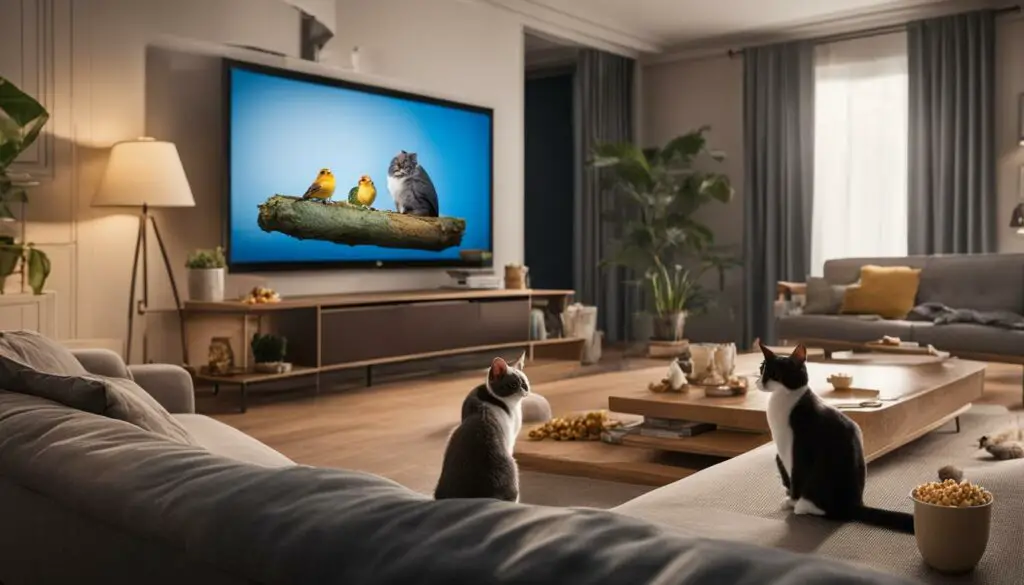
Whether we’re watching a nature documentary, a comedy show, or a thrilling movie, the act of TV watching allows us to bond over a shared experience. We can laugh together at funny scenes, feel a sense of awe at the beauty of nature, or empathize with the characters on the screen. These shared emotional connections help to strengthen our bond and deepen our understanding of each other.
So, the next time you settle down to watch TV, invite your cat to join you. Create a cozy spot for them to relax and enjoy the show. Observe their reactions and share in their enjoyment. It’s not just about the content on the screen; it’s about the quality time and shared experiences that bring you closer together.
Cat Behaviorist Insights
Cat behaviorists provide valuable insights into the way cats perceive and interact with TV content. While dogs often display different behaviors when interacting with humans compared to other dogs, cats tend to treat humans similarly to how they would treat other cats. This suggests that cats may not fully understand the distinction between humans and other cats when it comes to socializing.
Cats exhibit social behaviors that are derived from their natural instinct to interact with their mothers and littermates. They may rub against their owners, raise their tails, and groom them, mimicking behaviors they would display towards other cats. Cats learn what works with different people and adapt their behavior accordingly. They may also form preferences for certain family members based on their individual behaviors, such as those who provide treats or attention at specific times.
Understanding Cats’ Social Behaviors
While cats may not fully comprehend the concept of TV or the content they are watching, they can still engage in social behaviors while in the presence of their owners. This behavior could be seen as a way to strengthen their bond with humans, as they use similar social behaviors they would use with other cats. It is important for cat owners to recognize and understand these behaviors to foster a positive and meaningful human-cat relationship.

Creating an enriching environment for cats involves providing mental stimulation, opportunities for engagement, and a space where they can display their natural social behaviors. TV watching can be part of this comprehensive approach to environmental enrichment, as it allows cats to engage with visual and auditory stimuli that can keep them mentally and physically active. By understanding and responding to cats’ unique behaviors and needs, owners can create a fulfilling and nurturing environment for their feline companions.
Understanding Cats’ Social Behaviors
When it comes to socializing, cats exhibit behaviors that are deeply rooted in their natural instincts. These behaviors are often derived from their interactions with their mothers and littermates. One common behavior is rubbing against their owners, which is a way for cats to mark their territory and show affection. In addition to rubbing, cats may also raise their tails, grooming their owners, and engage in other behaviors typically seen among cats.
Cats’ tail behavior is particularly interesting. A raised tail is a sign of friendliness and can indicate that a cat is feeling comfortable and content. On the other hand, a tucked or lowered tail may indicate fear or anxiety. Understanding and interpreting a cat’s tail behavior can provide valuable insights into their emotions and moods.
“Cats use a variety of behaviors to communicate their feelings and intentions, and tail behavior is just one aspect of their complex language,” says Dr. Emily Johnson, a veterinarian specializing in feline behavior. “By paying attention to their tail movements, we can gain a better understanding of how cats are feeling and provide them with the care and support they need.”
Cat Grooming: A Sign of Affection and Bonding
Grooming is another social behavior commonly observed in cats. When a cat grooms their owner, it is often seen as a sign of trust and affection. Cats groom each other as a bonding activity, and when they groom their owners, they are extending that sense of bonding to their human companions. It is a way for cats to show that they feel safe and comfortable in their presence.
It’s important for cat owners to reciprocate this grooming behavior by maintaining proper grooming habits for their feline friends. Regular brushing and grooming sessions not only help keep a cat’s fur healthy and free from matting but also strengthen the bond between the cat and their owner. Grooming sessions provide an opportunity for interaction and physical contact, which can further deepen the connection between the two.
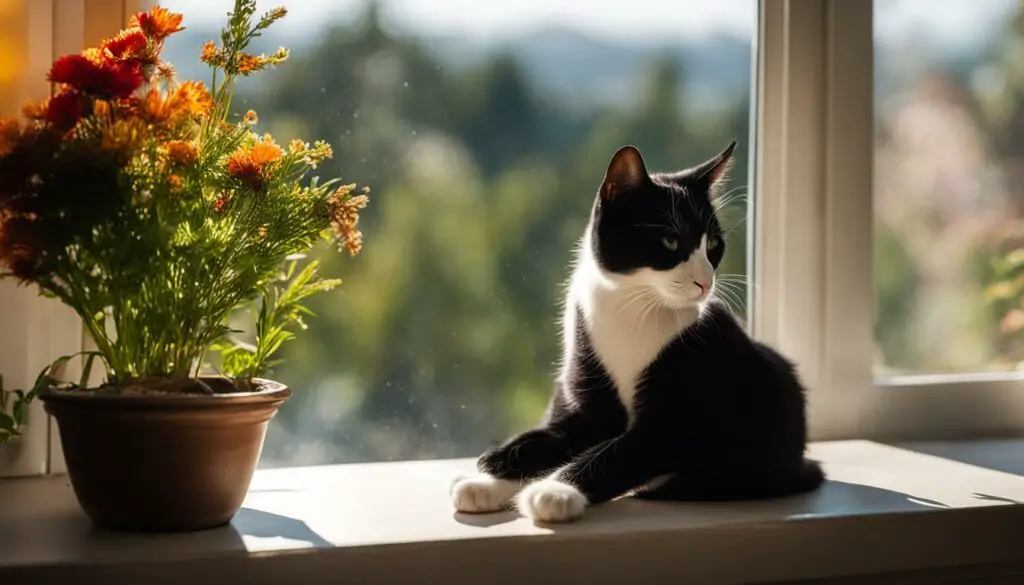
| Grooming Behavior | Meaning |
|---|---|
| Licking and nibbling | Sign of affection and grooming |
| Gently biting | Playful behavior or a way to get attention |
| Excessive grooming | May indicate stress or anxiety |
| Absence of grooming | Could be a sign of illness or discomfort |
Understanding cats’ social behaviors, such as tail movements and grooming habits, can help foster a stronger bond between cat owners and their feline companions. By recognizing and responding to these behaviors, cat owners can create a nurturing and supportive environment that promotes the overall well-being of their furry friends.
The Importance of Environmental Enrichment for Cats
Providing mental stimulation and enrichment is crucial for the overall well-being of cats. Environmental enrichment can help reduce stress, prevent boredom, and promote a healthy and happy feline life. TV watching can be a part of this comprehensive approach to environmental enrichment, offering cats opportunities for mental stimulation and engagement.
By exposing cats to TV content that aligns with their interests, owners can provide a source of mental stimulation and relaxation. Whether it’s nature shows featuring wildlife, animated videos that tap into their hunting instincts, or interactive virtual experiences, TV watching can captivate cats and keep them mentally active.
In multi-cat households, it’s important to ensure that each cat has access to their preferred TV content to avoid conflict. By creating individual viewing areas or providing multiple screens, owners can cater to the individual preferences of each cat and minimize potential tensions.
The Benefits of TV Watching for Cats:
- Provides mental stimulation
- Reduces stress and anxiety
- Alleviates boredom and prevents destructive behavior
- Offers opportunities for engagement and entertainment
- Enhances a cat’s overall psychological well-being
Environmental enrichment is essential for cats, and TV watching can be a valuable tool in achieving this. By incorporating TV content that stimulates their natural instincts, cat owners can offer their furry companions a more enriching and fulfilling life.
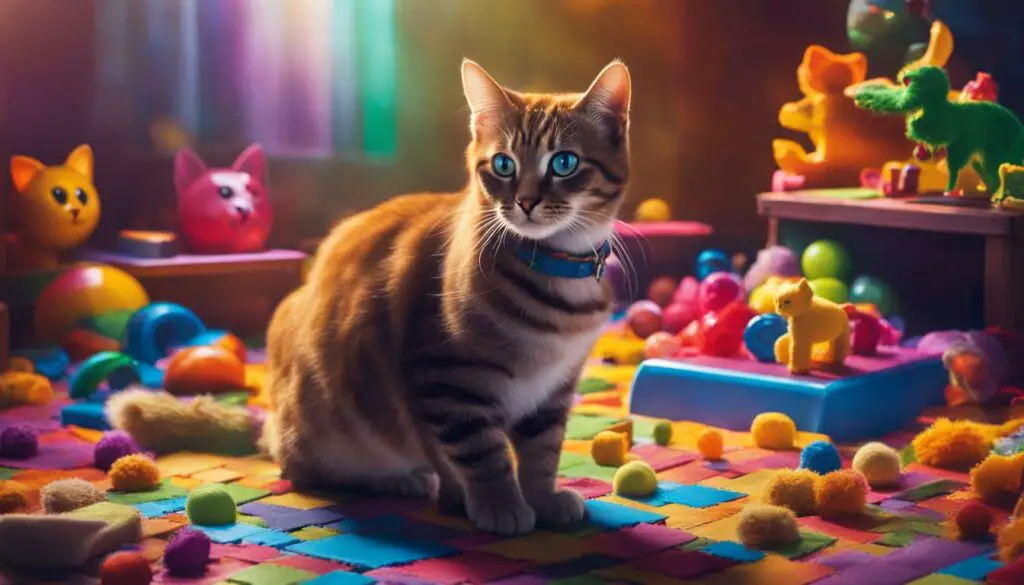
Conclusion
Throughout this article, we have explored the fascinating topic of cats and their love for watching TV. While not all cats may enjoy this form of entertainment, many exhibit signs of enjoyment, engagement, and relaxation when exposed to certain content. TV watching can provide cats with mental stimulation and enrichment, contributing to their overall well-being.
By understanding and respecting a cat’s individual preferences, owners can enhance their feline friend’s TV-watching experience. Whether it’s nature shows depicting wildlife, animated videos designed for interactive play, or virtual reality experiences that simulate a hunting environment, there are various options available to cater to a cat’s interests and instincts.
TV watching can also serve as a bonding activity between humans and their cats. Sharing quality time together and enjoying the same content can strengthen the human-cat bond, deepening the connection between them. Additionally, by providing an enriching environment that includes TV watching, owners can promote their cat’s mental stimulation and reduce boredom and stress.
In conclusion, while the topic of cats and TV watching may require further research, it is clear that for many cats, this form of entertainment can provide mental stimulation, relaxation, and enrichment. So why not grab a cozy spot on the couch and enjoy some quality TV time with your feline companion?
FAQ
Do cats really enjoy watching TV?
Many cat owners have observed that their cats show signs of enjoyment and engagement while watching TV, suggesting that they do find it entertaining. However, not all cats have the same level of interest in TV.
Can TV watching benefit cats?
Yes, TV watching can provide mental stimulation, relaxation, and enrichment for cats. It can help reduce boredom, alleviate stress, and keep them mentally and physically active.
What type of TV content do cats prefer?
Cats have individual preferences when it comes to TV content. Some may enjoy nature shows featuring wildlife, while others may be captivated by cartoons or videos that depict birds, fish, or mice.
How does TV watching impact a cat’s mental health?
TV watching can have a positive impact on a cat’s mental health by providing mental stimulation and reducing stress and anxiety. The visual and auditory stimuli in TV content create a more enriching environment for cats.
Is it important to approach TV watching responsibly?
Yes, moderation is key when it comes to TV watching for cats. Excessive screen time can lead to overstimulation or addiction-like behavior. It’s also important to choose appropriate content and protect their eyes by adjusting screen distance and brightness.
Can TV watching strengthen the bond between cats and humans?
Yes, TV watching can be a bonding activity between cats and their owners. Sharing quality time and enjoying the same content can deepen the connection between a cat and their human companion.
How does TV watching contribute to a cat’s environmental enrichment?
TV watching provides mental stimulation and engagement, which are essential for preventing boredom and reducing stress in cats. It can be part of a comprehensive approach to environmental enrichment.
Are cats’ social behaviors influenced by TV watching?
Cats’ social behaviors, such as rubbing against their owners or sitting beside them, are derived from their natural instinct to interact with their mothers and littermates. TV watching may not directly influence these behaviors.
How can TV watching benefit cats in multi-cat households?
In multi-cat households, it’s important to ensure that each cat has access to their preferred TV content to minimize conflicts. TV watching can provide mental stimulation and reduce stress for cats living together.

